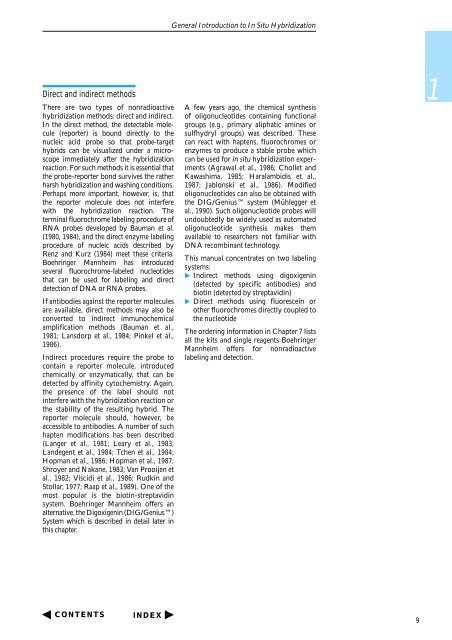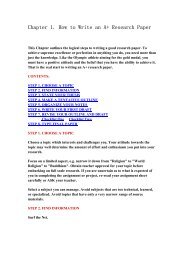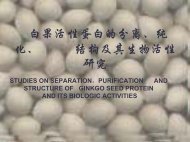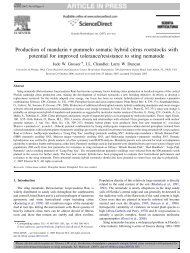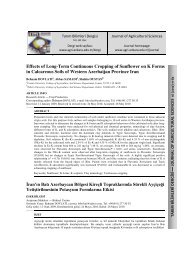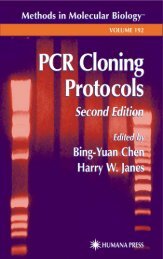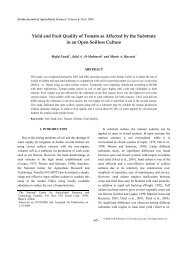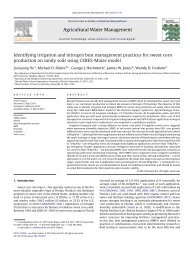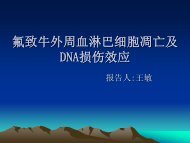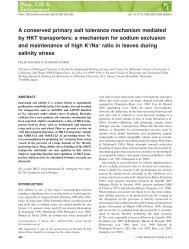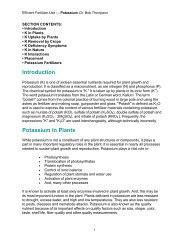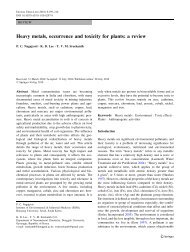General Introduction to In Situ Hybridization
General Introduction to In Situ Hybridization
General Introduction to In Situ Hybridization
You also want an ePaper? Increase the reach of your titles
YUMPU automatically turns print PDFs into web optimized ePapers that Google loves.
Direct and indirect methods<br />
There are two types of nonradioactive<br />
hybridization methods: direct and indirect.<br />
<strong>In</strong> the direct method, the detectable molecule<br />
(reporter) is bound directly <strong>to</strong> the<br />
nucleic acid probe so that probe-target<br />
hybrids can be visualized under a microscope<br />
immediately after the hybridization<br />
reaction. For such methods it is essential that<br />
the probe-reporter bond survives the rather<br />
harsh hybridization and washing conditions.<br />
Perhaps more important, however, is, that<br />
the reporter molecule does not interfere<br />
with the hybridization reaction. The<br />
terminal fluorochrome labeling procedure of<br />
RNA probes developed by Bauman et al.<br />
(1980, 1984), and the direct enzyme labeling<br />
procedure of nucleic acids described by<br />
Renz and Kurz (1984) meet these criteria.<br />
Boehringer Mannheim has introduced<br />
several fluorochrome-labeled nucleotides<br />
that can be used for labeling and direct<br />
detection of DNA or RNA probes.<br />
If antibodies against the reporter molecules<br />
are available, direct methods may also be<br />
converted <strong>to</strong> indirect immunochemical<br />
amplification methods (Bauman et al.,<br />
1981; Lansdorp et al., 1984; Pinkel et al.,<br />
1986).<br />
<strong>In</strong>direct procedures require the probe <strong>to</strong><br />
contain a reporter molecule, introduced<br />
chemically or enzymatically, that can be<br />
detected by affinity cy<strong>to</strong>chemistry. Again,<br />
the presence of the label should not<br />
interfere with the hybridization reaction or<br />
the stability of the resulting hybrid. The<br />
reporter molecule should, however, be<br />
accessible <strong>to</strong> antibodies. A number of such<br />
hapten modifications has been described<br />
(Langer et al., 1981; Leary et al., 1983;<br />
Landegent et al., 1984; Tchen et al., 1984;<br />
Hopman et al., 1986; Hopman et al., 1987;<br />
Shroyer and Nakane, 1983; Van Prooijen et<br />
al., 1982; Viscidi et al., 1986; Rudkin and<br />
S<strong>to</strong>llar, 1977; Raap et al., 1989). One of the<br />
most popular is the biotin-streptavidin<br />
system. Boehringer Mannheim offers an<br />
alternative, the Digoxigenin (DIG/Genius)<br />
System which is described in detail later in<br />
this chapter.<br />
CONTENTS<br />
INDEX<br />
<strong>General</strong> <strong><strong>In</strong>troduction</strong> <strong>to</strong> <strong>In</strong> <strong>Situ</strong> <strong>Hybridization</strong><br />
A few years ago, the chemical synthesis<br />
of oligonucleotides containing functional<br />
groups (e.g., primary aliphatic amines or<br />
sulfhydryl groups) was described. These<br />
can react with haptens, fluorochromes or<br />
enzymes <strong>to</strong> produce a stable probe which<br />
can be used for in situ hybridization experiments<br />
(Agrawal et al., 1986; Chollet and<br />
Kawashima, 1985; Haralambidis et al.,<br />
1987; Jablonski et al., 1986). Modified<br />
oligonucleotides can also be obtained with<br />
the DIG/Genius system (Mühlegger et<br />
al., 1990). Such oligonucleotide probes will<br />
undoubtedly be widely used as au<strong>to</strong>mated<br />
oligonucleotide synthesis makes them<br />
available <strong>to</strong> researchers not familiar with<br />
DNA recombinant technology.<br />
This manual concentrates on two labeling<br />
systems:<br />
<strong>In</strong>direct methods using digoxigenin<br />
(detected by specific antibodies) and<br />
biotin (detected by streptavidin)<br />
Direct methods using fluorescein or<br />
other fluorochromes directly coupled <strong>to</strong><br />
the nucleotide<br />
The ordering information in Chapter 7 lists<br />
all the kits and single reagents Boehringer<br />
Mannheim offers for nonradioactive<br />
labeling and detection.<br />
9<br />
1


